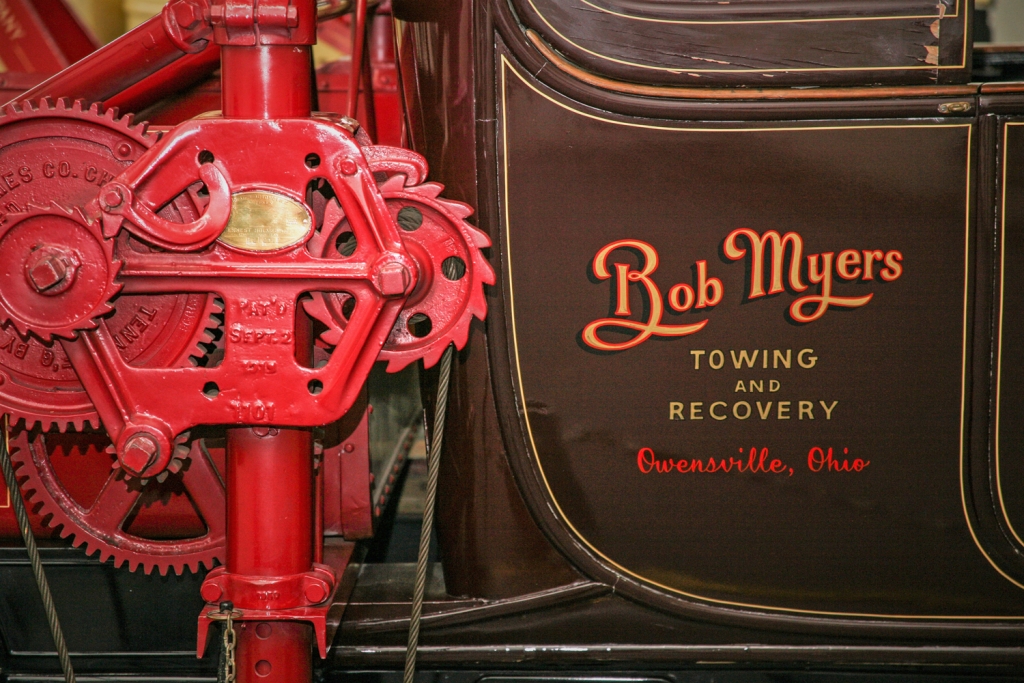How do you as a sign artist (sign painter?) feel about restored, commercial vehicles – or race cars – of the pre-vinyl era that are displayed in a museum exhibit with cut vinyl letters, or vinyl gold leaf, instead of the hand lettering that would have been present on the original?
Last Sunday morning, I asked this question of Cincinnati’s renowned pinstriper, gilder and sign artist Jim “Dauber” Farr. In reply, he recounted how he had recently visited the Gilmore Car Museum (Hickory Corners, MI) and there noticed that several of their historic race cars – a ’47 Hudson pickup and a ’49 Cadillac in particular – were decorated with vinyl letters instead of era-appropriate hand-painted letters. Dauber said, “I went to the curator’s office and complained, but they excused the vinyl as the decoration method on the cars when they received them.”
This question and conversation started when, on the previous Sunday, my wife and I visited the International Towing and Recovery Hall of Fame and Museum in Chattanooga, TN because, like Dauber, I was enjoying the beautifully restored vehicles (tow trucks, here) but soon disappointedly realized that several pre-1982 models were decorated with vinyl letters.
Why pre-1982? Gerber Scientific introduced the first vinyl cutter, the Gerber III, in 1982; thus any vehicles that precede that date, to be accurately displayed, would have painted graphics, not cut or printed vinyl. Like the reply to Dauber at the Gilmore museum, the Chattanooga museum attendant said their vehicles were exhibited as they appeared when donated.
I asked Dauber if he felt a museum should change out vinyl letters for era-appropriate hand-brushed letters on pre-1982 vehicles.
“Hell, yes,” he said, not mincing words and adding, “Any museum-displayed vehicle graphics should be correct for the vehicle date.”
Advertisement
The Indianapolis Motor Speedway Museum is a great place to see the vehicle graphic transition from paint to vinyl to digital print. Its 36,000-sq.-ft. galleries exhibit race cars – Indy, Formula One, Sprint, Midget, plus drag racers and motorcycles. There, you can enjoy studying the development and progression of decoration styles and the paint to vinyl to ink transitions, each appropriate for the vehicle era and thus institutionally correct.
And, it’s the same with gold leaf – gilding – because even though imitation gold leaf or vinyl-backed leaf is effective, less expensive and quicker (and most people wouldn’t know the difference), any collector, historian or reader of Kent Smith’s “Gold Leaf Techniques” will immediately see the difference. These and other hand-painted indicators authenticate the past, a time when charming, but air-defiling land barges ruled the roads.
My primary point is that museum exhibits should be accurate. You might drive across town to see Carroll Shelby’s original Cobra, the 1962 CSX 2000, but not cross the street to see a 2017 imitation. My point? When you make the effort to see an advertised original, you expect to see an accurate original.
Am I too exacting?
That same Sunday afternoon, I talked with Bob Bond, publisher/editor of AutoArt & Kustom Painting Magazine and pinstriper, gilder and signmaker extraordinaire, who said any old or historical vehicle displayed by a museum should replicate the original as closely as possible. “Museums are preserving history,” he said, “so the visuals need to be period-accurate.”
Tod Swormstedt, the American Sign Museum founder and past editor and publisher of this magazine also answered my phone call on that Sunday. I told him what I was writing and asked what he would do if the museum received an antique sign, one that would have been hand lettered originally, but instead sported vinyl letters. Tod said he hasn’t faced such a predicament, but surely wouldn’t accept the sign. “We like to leave exhibited signs as they are,” he said, “and wouldn’t want to have to strip and repaint one.”
Advertisement
A more philosophical view might be taken from Faythe Levine and Sam Macon’s book “Sign Painters” where in the introduction, Glenn Adamson, head of research at the Victoria and Albert Museum (London), said, “… it is only now, as we cross the digital divide that it seems to make sense to celebrate sign painting.” He noted that handmade signage is no longer the norm, but the exception – a trace of a slower, less hurried era. He also noted that sign artists themselves are not disappearing and those who still accomplish the work, “deserve to be taken as the inventive, vital artists that they are, rather than as remnants of a vanishing past.”



 Tip Sheet4 days ago
Tip Sheet4 days ago
 Business Management2 weeks ago
Business Management2 weeks ago
 Women in Signs2 weeks ago
Women in Signs2 weeks ago
 Real Deal5 days ago
Real Deal5 days ago
 Benchmarks1 day ago
Benchmarks1 day ago
 Editor's Note1 week ago
Editor's Note1 week ago
 Line Time2 weeks ago
Line Time2 weeks ago
 Product Buying + Technology1 week ago
Product Buying + Technology1 week ago











